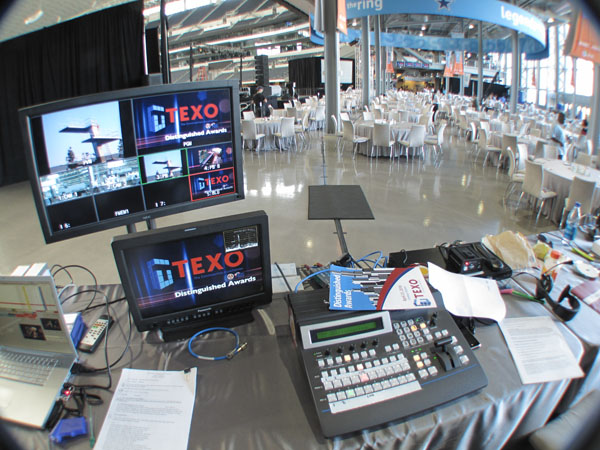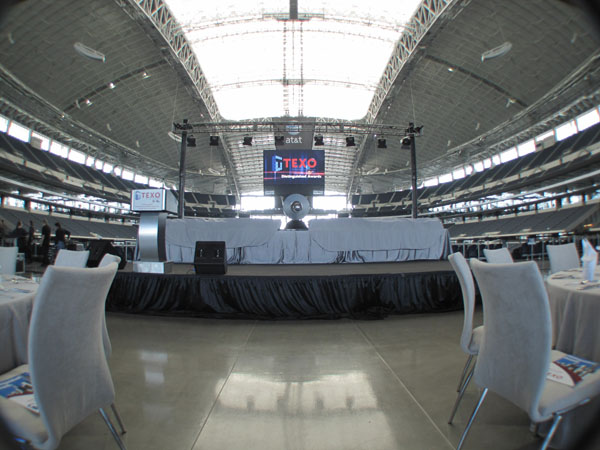Review: Panasonic AV-HS400N HD Video Mixer
HD video mixers aren't cheap, but they do offer amazing functionality inside compact boxes. I put Panasonic's AV-HS400N through its paces during an awards ceremony. I found much to like, and a few minor issues, and look forward to technologies like this becoming more affordable in the years to come.
When I had the opportunity to engineer and direct a multicamera live awards banquet at the brand new Cowboys Stadium just outside Dallas, Texas, the hub I chose for all the video was Panasonic's AV-HS400N, a nicely packaged video mixer that supports up to 8 inputs and outputs, modular configuration, and built-in multiviewer. The modular configuration allows the mixer to ship with four HD-SDI inputs, and you can add 4 more HD-SDI inputs, or two component analog inputs, or two DVI inputs. You can also augment the onboard outputs with four HD-SDI outputs or DVI/Component output board. Ours sported the latter configuration.
We used the four built-in HD-SDI inputs, and added two component analog inputs via the AV-HS04M2 board. We used the DVI output for the multi-viewer to a large plasma display. With the built in crosspoint router, I was able to assign whatever input to a particular button on the mixer, making it easy to mentally arrange the cameras, blu-ray playback, two laptop inputs and more on the face of the mixer. This way I could easily punch what I wanted, and not have to hunt around on the mixer for an input.

Our mixing setup with the Panasonic AV-HS400N at Cowboys Stadium
Sending an IMAG Feed to the World's Largest HD Video Display
I would be directing IMAG and recording of TEXO's Distinguished Awards dinner at Cowboys Stadium. Yes, the same stadium with the world's largest HD video display hanging over the center of the field. I was told that part of my IMAG would be using the LED display over the field. However, when I arrived and found the location of the stage area was to be behind one of the end zones, I realized that I'd be using one of the much smaller LED displays that capped the sides of the massive displays that faced the two sidelines.

The IMAG projection at the TEXO Distinguished Awards dinner
Still, it was impressive to have my video appear on such a large and bright display. We had originally intended on splitting the video feed to the LED display, and the two rear-projector screens on either side of the awards stage, and using them separately. As a result, I had set up the HS4000 so that I could mix the A/B buses to the projection screens, and I would use the AUX bus to feed the LED display. We ran through the show several times, outlining when live IMAG would be on the side screens, and the awards recipient text would be on the LED screen, when all three would have the same video, throughout the 3+ hour, nonstop event. It was going to be a tricky feat punching two different programs on the same mixer at the same time.
AUX Limitation
My plan was to set up the HS400's built-in multiviewer to show me all my video sources, as well as my outputs, so I could easily make sure I was sending the right thing with one glance. This is when I hit my first roadblock. I could not put the AUX output into the multiviewer. It handled only inputs, internal still buffers, black (essentially turning that part of the multiviewer off), preview, and program.
Not to be dissuaded, I tried to send one of the mixer's customizable outputs back into one of the mixer inputs so I could see it on the multiviewer. However, in the heat of battle, the possibility that I could punch the return feed and create a loop led me to use a second physical monitor for AUX monitoring. This also enabled me to be able to see a waveform scope. The waveform is feature that so many products are incorporating these days, I was surprised it wasn't built into the HS400. With it, I could more accurately match my cameras and also tweak the settings on the laptop inputs so they weren't blowing out superwhite video.
Once we started seeing how good the LED display was compared to the rear-projection screens, we started to change the program to make more use of it. The color was so vibrant and, because our program was starting an hour before sunset, we had no issues with ambient light washing out the screen like there were in the rear-projection screens. We were in Cowboys Stadium, remember, with 6-story glass doors behind us, and a massive stadium in front of the audience. That's a lot of ambient light.
Being able to see the LED screen became critical as we determined that we would rely on it as much, if not more than the side screens. Since the HS400 can route both preview and program in the multiviewer, I was surprised that it did not have the ability to incorporate the AUX feed into the multiviewer somewhere. Perhaps, as a software-driven device, this could be possible in a future firmware upgrade.